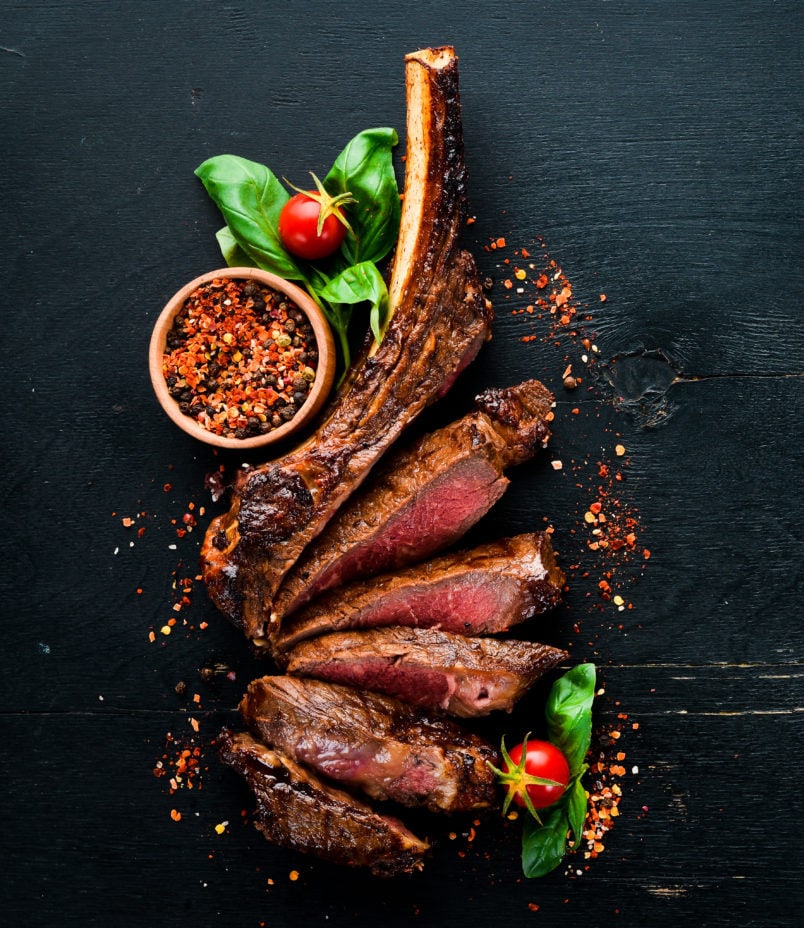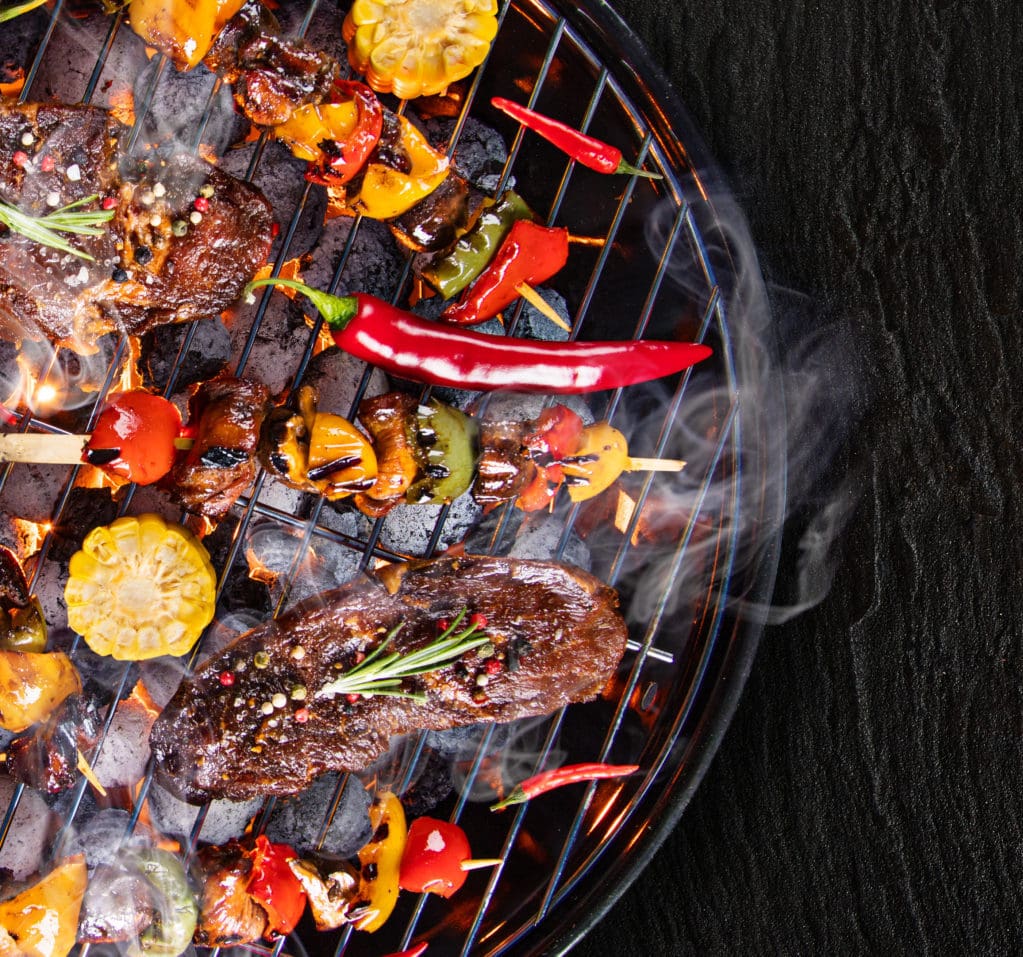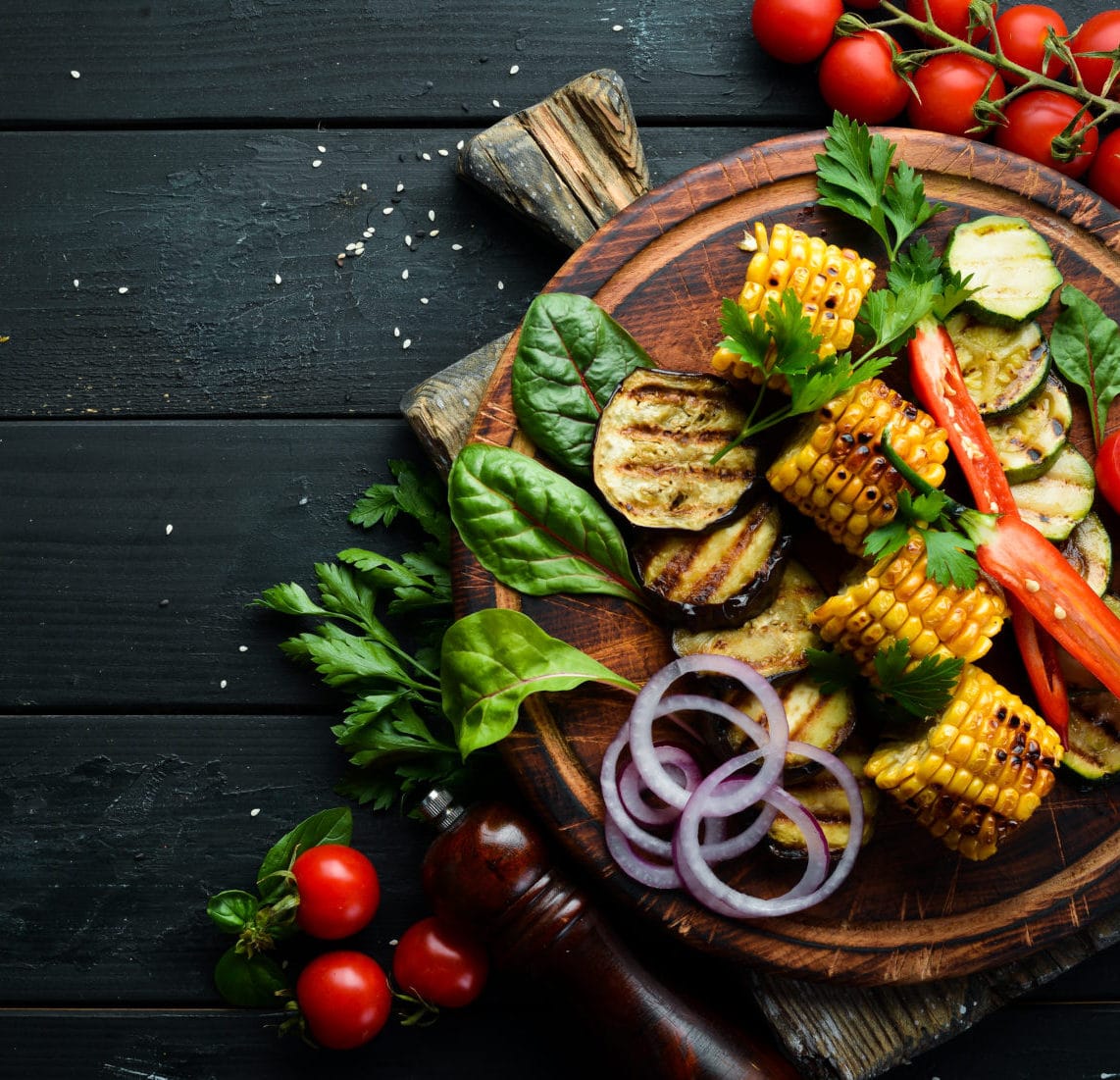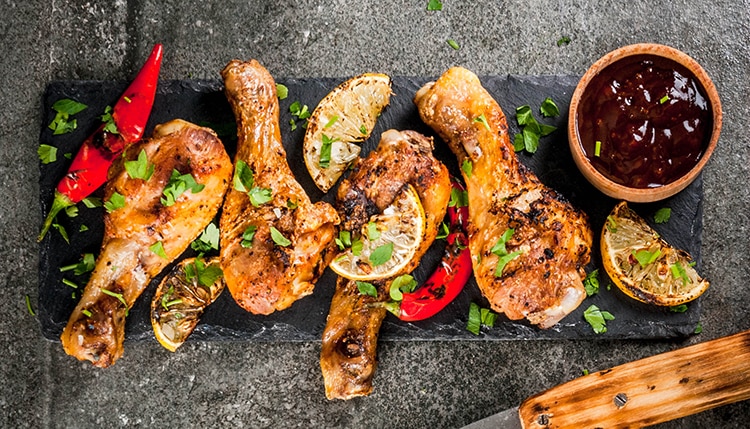Grilling is a primal process, cooking outdoors over an open flame, similar to how our early cave ancestors did. It has a ritualistic flavor, and there’s often a social component, too — the gathering of family and friends to share in a communal feast. Whether you’re gassed about gas, or you place your bets on briquettes, there’s no denying that grilling is fulfilling.
Fueling the Debate
The debate over whether charcoal is better than gas can get pretty, well, heated. And then there are electric grills to consider. A few factors play into the choice.
Ease Of Use
Clearly, an electric grill’s the easiest and most convenient, assuming you have an outdoor outlet, you simply flip a switch and you’re good to go. Next easiest is a gas grill. But that can mean a propane tank to swap out, or access to your home’s natural gas. Finally, there’s charcoal, which brings briquettes, starter, lighters, emptying ashes, etc.

Authentic Off-The-Fire Flavor
Chef Ben Parks, co-owner of Barred Owl Butcher & Table, says, “There’s no question that charcoal grilling provides better flavor but takes more time to get ready and a little more skill as far as controlling the temperature and evenness of the heat. Gas grilling has the convenience factor though, which makes it appealing as well.”
The further you move away from wood as your heat source, the less of that smoky, off-the-fire flavor you’re going to get. Charcoal grills not only smoke meats better than gas, they also release a chemical called guaiacol. Guaiacol is an aroma compound that gives meat a smoky, bacon-like flavor, and it only comes from wood and charcoal.
The average charcoal grill heats up to around 200 degrees hotter than your average gas grill. This is often a selling point for charcoal, because certain recipes and dishes call for high- heat searing.
For Dustin Norem, managing partner at CC’s City Broiler, cooking over actual oak wood would be his preference for grilling. “It has such a high heat it allows you to sear a steak unlike any gas or charcoal grill can do. If I had to choose between gas and charcoal, I would go with charcoal and adding wood chips to not only to up the temperature, but also to give your steak or whatever you may be grilling a touch of smoky flavor.”
Safe Surroundings
If you have a small patio or balcony, or one that’s covered, a large charcoal grill’s not a good idea. There’s a lot of smoke while getting one started and they’re prone to flare-ups during cooking. A small one’s a better bet, but electric grills are safer in small areas such as these. Another caution: Gas grills produce flare-ups, too, so they shouldn’t be too used too close to any structure where they might start a fire.
Grilling Style
If you’re mainly after a quick-fix dinner on a worknight with a minimum of effort, a gas or electric grill is the ticket. But if you prefer a more relaxed ritual of cooking, along with the most authentic off-the-fire flavor, then charcoal’s the charm. Avid griller Devin Rodino, a regular customer at Barred Owl’s butcher shop, employs both methods. “Charcoal is my preferred method. I like the flavor as well as just the ‘event’ of grilling with charcoal, but I often use gas for quick weeknight grilling or if I’m just doing a couple burgers.”
Cost
In terms of initial outlay, charcoal grills are cheaper than gas or electric ones. Electric grills are typically the cheapest to operate. But, in terms of fuel, charcoal is more expensive than electricity or natural gas and may cost you more in the long run, particularly if you’re using natural gas from your home hookup, as opposed to propane tanks.
THE GRILL DRILL
There are some rules you should always follow no matter what kind of grill you’re using or what you’re cooking.
- Keep your grill grate clean so stuff doesn’t stick
- Have the right tools in easy reach
- Allow adequate time for the grill to heat up before cooking
- Always keep an eye on what you’re grilling
- Don’t add sugary sauces or marinades to meat on the grill — it’ll cause burning over an open flame
Meat Matters
Parks says the best cuts for grilling are usually going to be the ones from muscles that don’t get much work as the animal is walking around. “In pigs and cows, that’s mostly the ones along the back that everyone is familiar with like loins, tenderloins, strips and rib eyes,” he says. “Towards the back you start to get leaner and a little tougher but there are still great grilling cuts like sirloin there.”
He says some of the best sellers at Barred Owl’s butcher shop are lesser known cuts. “Some of our more popular cuts are obscure muscles that you can’t find elsewhere because they take a little more time to get to. For example, the chuck or shoulder part of the cow is usually just turned into ground beef but it’s such a complicated group of muscles that there are some great tender cuts if you know what you’re looking for, things like Denver and Ranch steaks are really popular for us,” he says.
When it comes to beef, Norem highly recommends trying some of CC’s Akaushi selections, saying they “have a wonderful buttery flavor that you just can’t beat. It’s a Japanese breed that came over to the states back in the mid-‘90s and our guests love it.”
Both Parks and Norem say other meats are also great candidates for the grill. “As long as it’s a nice, tender cut, any meat is great for grilling. Grilled lamb is especially good, the smokiness of the grill really compliments the flavor,” Parks says. He encourages grillers to move beyond meat, trying fish and other options. “Grilled seafood can also be great; grilled shrimp is a great place to start.”
STRIP TIP
Cut from the short loin, a strip steak is a tender, lean cut that has a bit of marbling throughout the meat and is perfect for grilling. It may be labeled as either a New York Strip or a Kansas City. The main difference between the two is that a Kansas City strip has a bone along the side.
Proper Prep
Parks says one of the keys to great grilling is meat quality. “If you’re using high-quality meats, you’re usually best off using salt and pepper and letting the flavor of the meat stand alone.”
Norem’s on the same page.
“You’re able to appreciate the flavor of what you paid for. Simple salt and pepper with a touch of garlic and you’re done. I’m a huge fan of truffle salt and pepper. The aroma of the truffle salt makes the whole experience even better.” Ideally, you should spice/season your food at least an hour before you’re going to grill it, so the flavor can soak in.
Parks and Norem generally advise against trimming off fat. “I don’t recommend trimming fat off before pretty much any cooking process,” Parks says. “Fat = flavor. For grilling especially, the smoke that comes from the rendered fat hitting your coals is where the best grilled flavor will come from.” Norem says you shouldn’t worry about trimming off any fat unless it’s excessive, for example, the fatty tail of a rib eye. He also advises allowing the cut to relax out of the fridge before putting it over heat. “It reduces the likelihood of it shocking the steak therefore making it tough,” he says.
Grilling fan Rodino agrees. “I like to let my steaks come up to closer to room temperature before throwing them on the grill.”
Marinade Myths
Some grillers maintain marinating is the secret to success. And although it can add lots of flavor, particularly to lean cuts that lack flavor from fat or marbling, marinating doesn’t make meat more tender. Acidic ingredients, such as lemon juice, vinegar or wine do affect meat. But they make it firmer, not more tender. Essentially, marinades just coat the surface of the meat but don’t really penetrate very far into it.
Norem is not as much a fan of marinating as he is of brining, especially pork and chicken, as it adds flavor and makes the meat juicier and more tender. He says he wouldn’t marinate anything other than seafood with an acidic/citrus marinade, and even then, you need to be very careful as to how long you marinate because you can end up with a tough end product.

“Marinating for long periods of time can definitely affect the texture of the meat in an unpleasant way,” Parks says. “That being said, a quick marinade for an hour or two can give your meat some added flavors if you’re looking for it. As far as making lean cuts more tender on the grill, the only surefire thing is to physically break up the muscle fibers either by pounding or using a device that pokes the meat with a bunch of little knives called a jaccard.”
Dry Rub Rules
Parks says if you’re looking for a specific flavor profile across your meal, there’s nothing wrong with rubbing it with some spices. Ingredients may include sea salt, brown sugar, cayenne pepper, paprika, garlic powder and more. Norem suggests adding a touch of brown sugar to your seasoning, especially if you like a sweet/salty combination. “Also, cutting a Cajun spice with brown sugar will take away the heat and just give you a more flavorful end product,” he says.
It’s best to use a two-handed approach: One hand to scoop and sprinkle the rub and the other to massage it into the meat on all sides. A common rule of thumb is 1 tablespoon of rub for every pound of meat. Just remember that the more you apply, the more strongly you’ll taste it. And although you’d think that wrapping dry rubbed meat in plastic wrap will enhance the flavor, removing the wrap can actually remove a lot of the rub.
Note: There are “wet rubs,” which might use the same seasonings as dry ones, but they’re suspended in cooking oil or some other liquid. Sometimes it’s a matter of the flavor you want to impart. If you like soy sauce, for instance, there’s no way to really duplicate that with dry ingredients only.
WOOD SMOKE 101
To add extra smoke to your grilling, add wood chunks. Good smoke is produced by hardwoods, which are low in resin and high in flavor. First, soak your hardwood chunks in water. Chunks should be saturated but not dripping when added, so let them drain.
Barred Owl Butcher & Table’s Ben Parks says they use different woods for different things. “For a traditional beef barbecue, you’ll usually use a stronger flavored wood like hickory or mesquite whereas for more delicately flavored things like pork you might use more fruitwoods like apple or cherry or a combination.”
FOR A CHARCOAL GRILL
You can add the wood directly to the coals once your fire’s died down. Don’t waste the wood by adding it until you’re ready to cook.
FOR A GAS GRILL
It’s easiest to take your soaked wood and place it in a foil packet. Poke a few holes to let the smoke through. Cleanup bonus: All you have to do is throw out the packet after it’s cooled down.
Temp & Timing
What you’re cooking will determine how hot you want your grill and also how long it will take. Parks shares a tip: “Make sure that your grill is hot enough that your meat won’t stick to it,” he says. “The other part of that is making sure that your grill is clean and well-oiled. Before you put the meat on, make sure you brush it clean and oil it. Using an old dish towel soaked in cooking oil is the best thing.”

Hot + Hurried
A hot grill is going to give you a high temp and cook food hot and fast. This approach is perfect for thin cuts of meat and smaller items such as kabobs, steaks, chops, burgers and hot dogs. On a charcoal grill, open the vents wide to allow more oxygen in. This will make the coals burn hotter.
Lower + Slower
Fish, chicken, vegetables and fruit are better grilled at lower temperatures, and will take longer. Aim for medium heat with these foods. On a charcoal grill, close the vents partially to slow down the cooking process. Don’t shut them completely, however, or you’ll totally suffocate the fire.
Source Course
Again, what you’re cooking will determine how close you want your food to the heat source: directly over it or adjacent.
Direct grilling
As the name implies, you’re cooking directly over the heat source. Many people leave the lid off when cooking this way, but by closing it, you’ll reduce cooking time and cook through to the center faster. Of course, you’ll still need to monitor and turn things.
Indirect grilling
This method means you’re cooking adjacent to the heat source. The “fire” is off to the side of where the cooking will take place, hence, cooking it indirectly. It’s not unlike baking. When you close the lid, convection and radiant heat cook the food. It’s best to indirectly grill anything that will burn on the surface before it can get cooked through to the middle, such as cuts of meat over 2 inches thick, poultry, roasts, etc.
IT’S A DONE DEAL
Parks stresses two final keys to successfully serving up great grilled meats. “Two of the most important things for cooking any meat are to use a good instant-read thermometer and to allow your meat to rest for 10 minutes. Every cut is slightly different so unless you’re an expert the only way to know how done it is by temperature. Take into account carryover cooking. Resting also lets the juices reabsorb and redistribute so you don’t lose a bunch when you cut into it.”
Norem strongly seconds this advice. “Most people don’t think about the fact that a protein will continue to cook after it’s off the grill and that’s exactly where the mistake is made.”
CHICKEN AND TURKEY
Cook to 165°. Juices run clear, meat is no longer pink.
BEEF AND LAMB
Rare: Cook to 125°. Meat will have a cool red center.
Medium: Cook to 135°-140°. Meat will have a warm pink center.
Well-Done: Cook to 155°+. Meat will have little or no pink.
Ground: Cook to 160°. Meat will have no pink.
PORK
Meat should be opaque with a slightly pinkish tint. Juices run clear or slightly pink.
Medium: Cook to 150°.
Well-Done: Cook to 160°.
Ground: Cook to 160°.


